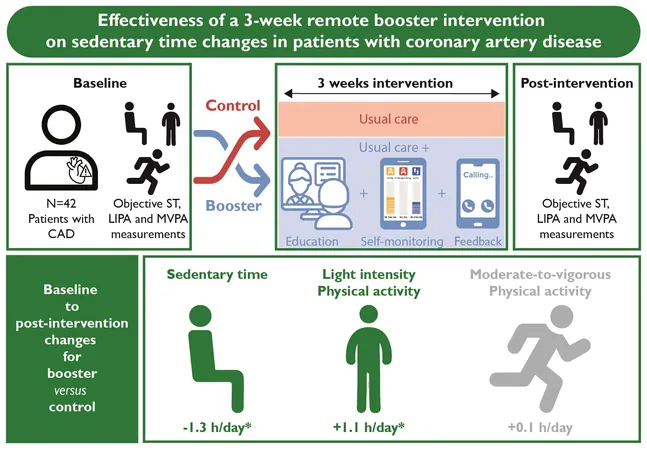
Revolutionary Remote Booster Program Slashes Sedentary Time After Cardiac Rehab!
2025-03-25
Author: Daniel
Introduction
After facing a cardiovascular event, many individuals struggle to sustain a healthier and more active lifestyle over time. While initial participation in cardiac rehabilitation programs can help reduce sedentary behavior, studies show that this reduction often seems to vanish within just three months post-rehabilitation.
Groundbreaking Research
Groundbreaking research from Radboud University Medical Center reveals that a targeted remote booster program for chronic cardiovascular patients can significantly decrease sedentary time while simultaneously increasing light physical activity. This pivotal study, published in the prestigious European Journal of Preventive Cardiology, highlights a new approach to maintaining wellness after rehabilitation.
Challenges of Maintaining an Active Lifestyle
Maintaining an active lifestyle post-acute coronary syndrome has proven to be a formidable challenge. Throughout cardiac rehabilitation, patients benefit from supervised exercise training conducted by physical therapists and are often inspired to embrace a healthier way of living. However, lifestyle improvements—including reduced sitting time—frequently diminish after only a few months. Previous findings from Radboudumc have confirmed this troubling trend, raising a crucial question: How can individuals effectively sustain a healthier, more active lifestyle in the long run?
Introducing a Groundbreaking Remote Booster Program
In a bid to tackle this issue, physiologists at Radboudumc conducted a study examining the impact of a lifestyle booster program initiated two years after patients graduated from cardiac rehabilitation. In this innovative study, 42 participants were invited to join a booster program specifically designed to minimize daily sedentary time.
Participants were divided into two groups: one continued with usual care, while the other utilized a unique app to track their sedentary behavior and benefited from three coaching sessions delivered via phone and digital platforms by a dedicated researcher. Remarkably, those in the remote coaching group managed to cut down their sedentary time by over an hour each day! Additionally, they increased their light physical activity by nearly an hour daily.
Expert Insights
Sophie Kroesen, the study's lead author, expressed optimism about the findings: "Using an accelerometer, we observed significant improvements among those who received coaching. They sat notably less, and the boost in light physical activity strongly indicates they were moving more. This suggests that offering a remote booster program, even in a fully digital format, is an effective strategy."
Transforming Cardiac Recovery: What This Means for You
These compelling results underscore the importance of continued support for cardiac patients long after their rehabilitation concludes. The findings not only encourage health professionals to consider integrating such remote programs into recovery protocols but also serve as a beacon of hope for individuals working to reclaim their vitality after cardiac events.
If you or a loved one are navigating life after a heart-related incident, this research could be your next step toward a healthier future. Embrace the movement—less sitting, more living!



 Brasil (PT)
Brasil (PT)
 Canada (EN)
Canada (EN)
 Chile (ES)
Chile (ES)
 Česko (CS)
Česko (CS)
 대한민국 (KO)
대한민국 (KO)
 España (ES)
España (ES)
 France (FR)
France (FR)
 Hong Kong (EN)
Hong Kong (EN)
 Italia (IT)
Italia (IT)
 日本 (JA)
日本 (JA)
 Magyarország (HU)
Magyarország (HU)
 Norge (NO)
Norge (NO)
 Polska (PL)
Polska (PL)
 Schweiz (DE)
Schweiz (DE)
 Singapore (EN)
Singapore (EN)
 Sverige (SV)
Sverige (SV)
 Suomi (FI)
Suomi (FI)
 Türkiye (TR)
Türkiye (TR)
 الإمارات العربية المتحدة (AR)
الإمارات العربية المتحدة (AR)